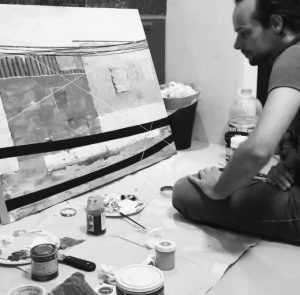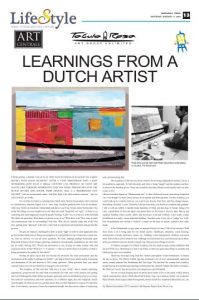 I’m reading a book “FALSE FLAT: WHY DUTCH DESIGN IS SO GOOD” by Aaron Betsky with Adam Eeuwens”. After a five-day Amsterdam visit, I kept wondering how such a small country can produce so many art giants like Vermeer, Rembrandt, and Van Gogh. Perhaps because the Dutch revere and honor their artists. There is a “REMBRANDT CITY SQUARE” with his monumental statue. And then there’s the ultra-modern museum – just for VAN GOGH’s art works.
I’m reading a book “FALSE FLAT: WHY DUTCH DESIGN IS SO GOOD” by Aaron Betsky with Adam Eeuwens”. After a five-day Amsterdam visit, I kept wondering how such a small country can produce so many art giants like Vermeer, Rembrandt, and Van Gogh. Perhaps because the Dutch revere and honor their artists. There is a “REMBRANDT CITY SQUARE” with his monumental statue. And then there’s the ultra-modern museum – just for VAN GOGH’s art works.

So we’d like to feature a contemporary Dutch artist, Martin Geuzendam, who’s married to a Dabawenya, Dayenne Sipaco. I’m a – since long – bachelor graduate from Fine Art Academy AKI (now ArtEZ) at Enschede, Netherlands and did a 2 year Fine Art pre-school before that. One of the first things we were taught was to not label any work “beautiful” nor “ugly”. As there is no such thing and such judgement would be deeply limiting. “Ugly” too, is in the eye of the beholder.
We rather ask questions. What does a work has to say to us? What does it do? How does it relate and communicate with its surroundings? And also: Why do you actually make this work? But also: getting more “physical” with one’s work (both in expression and materials) and get into the process.
We got, for instance, challenged to draw or paint “light” in order to seek approaches that go beyond the surface-level. Being encouraged to be experimental in use of materials, expression, etc. Also as viewers, we can ask more questions. We look, undergo, perhaps thousands upon thousands of pieces of art, images, paintings, sculptures, mixed-media, installations, etc. But what are we really looking for?! What’s the motivation to see, (trying to) make contact with and experience those works? What is it >> in essence << that we want to share in as public, of what is being presented to the public by the artists? Peeling all these layers that are beyond the artworks, the artist motivations and the motivations of the people watching it as “public”, can help to find (y)our (inner) search of meaning and destination of life and answers to life’s many questions. What questions have you asked yourself when you visit an exhibition or just get to see artworks? The Academy of Fine Arts that I did was a 4 year “study”: that is, mainly exploring, experiment, going beyond the safe-what-you-already-can with one’s work process and getting one’s self challenged to think further, go deeper, approach one’s art and thinking of art even closer. Not settle for convenience, ask more questions, try a different angle, dive into materials, stretch your thoughts on what can serve to get that across that you find important to express. It’s therefore also, if not mainly, a process of inner development brought into the creative plane of expressing and communicating that. The Academy I followed was always known for its being independent and free, I’d say a bit anarchistic, approach. To both the study and what is being “taught” and the students and how to relate to the freedom given. Those who needed a structure offered would usually back out after a year or two. I did my bachelor degree on “Monumental Arts”. At first I followed several years doing Sculptural Art, even though I’ve been (also) always an art painter and drawing artist. On this Academy you could walk up to a teacher and say you want to get lessons from then, and thus change classes. Something I did after years. Therefore I did an extra study year before to complete and graduate. I did so with an exhibit. I literally made hundreds of black ink drawings of human beings (A4 size), copied them to blue-ish paper and glued them on the house I lived in back then (a big squatted building where mainly artists and musicians lived and worked). I also made a huge installations in a partly vacant industrial building. Teachers came to my city to “judge” my work. Part of graduating was writing a “scriptie”, a paper on the topic of choice, related to the works made. In the Netherlands we pay quite an amount of taxes (at least 1/3th of our income). With these taxes a lot is being paid for our Dutch society. Healthcare, education, social housing, maintenance of roads, structures, nature, etc., building, water management, childcare and much more. Part of this is also Culture & Arts. Although a lot and many have seen financial cuts in there, as the government in power decides (simply put, there are more things involved). A Filipino can apply for a Dutch residency, but one needs to meet certain conditions that are not THAT easy. Best thing is to look it up online, as there are quite some things to consider and check given one’s own situation. There has, since ages long, been this “artistic atmosphere” in the Netherlands. A climate for arts to thrive. The Dutch Golden Age has produced a lot of now internationally appraised artists, mainly painters like Rembrandt and Van Gogh. The fact that the country had (wealthy) people buying arts and those giving huge commissions has certainly helped. But Zalso nowadays, the Dutch art “scene” has always been very progressive and influential. I’m not so much keeping track on artists but to name a few of the many widely known Dutch contemporary artists I think about Rob Scholte, Joep van Lieshout (Atelier van Lieshout), René Daniëls, Karel Appel, Daan Roosegaarde, Robert Zandvliet, Annemarie Busschers, etc., etc. _____________________________________________________________ By Martin Geuzendam (1977), married with Dayenne Sipaco from Davao City.

